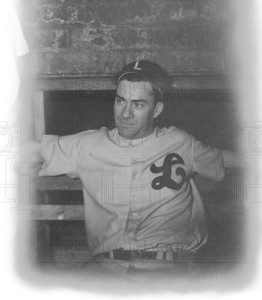
Last week we took a look at the uniforms worn by Jackie Robinson during his brief time in the Negro leagues, as a member of the Kansas City Monarchs of the Negro American League and the Kansas City Royals winter league team (not to be confused with the current MLB team of that name or the Montreal Royals, which was the Dodger affiliate Robinson played for before joining the Bums). It should be mentioned that Robinson in fact broke the organized baseball color barrier not in Brooklyn, but a year earlier in Montreal of the International League, and that he faced many of the same situations in cities like Baltimore and Syracuse that would become so familiar in his inaugural season with Brooklyn. (Fortunately, he was welcomed with open arms by Montreal’s rabid fans). Montreal was a farm team of Brooklyn, the farm system having been pioneered by Branch Rickey when he was general manager of the St. Louis Cardinals. At the time, most minor league teams were independent entities who sold players to the highest big league bidder. Rickey, being a parsimonious type, wanted more control of minor league affiliates and player development, so came up with a system (universal today) wherein the major league club owned outright or at least controlled the fortunes of their minor league affiliates. This is relevant to our discussion here, because in 1946 the Dodgers brought together all their minor league prospects in Spring Training in Daytona Beach, Florida.
Here we must digress a bit and discuss the fad that several major league teams, most notably the Dodgers, indulged in for select night games: satin uniforms. Brooklyn first broke out the satin togs in 1944, and appear to have worn four different satin designs through the early 1950s, when they were discontinued. It appears that many of the satin 1944 uniforms made their way to Florida for use by minor league prospects. (For a great primer on the history of satin uniforms in baseball, go here). The Royals appear to have removed the Dodgers lettering and substituted “Royals” in cursive script (the lettering material was also satin, and the Royals matched the uniforms with a matching white satin cap). Robinson is first shown in such a uniform, with a #30 affixed to the back.

Jackie Robinson, Spring Training 1946. Satin uniform.
Later on in Spring Training we see him in a regular season gray flannel Montreal road uniform with #9 on the back, the number he would use during the regular season, and this is the uniform Robinson wore when he broke in at Jersey City’s Roosevelt Stadium on April 15th, 1946, creating a stir with his magnificent offensive performance. Curiously, the satin uniforms do not seem to have made an appearance during the regular season, the home uniform being a standard creme design with “Royals” in blue felt across the front, similar to what the parent Dodgers wore, but with added blue trim. One interesting fact is that two variations of the white felt “M” adorned the wool cap during the season.

Robinson crosses the plate on 4/18/46, the first official organized baseball game which included an African-American player.

Circa 1944 Dodgers satin uniform. These were handed down to the Montreal farm club in 1946.

Royals’ regular season home flannel.

1946 Montreal Royals Satin Cap






